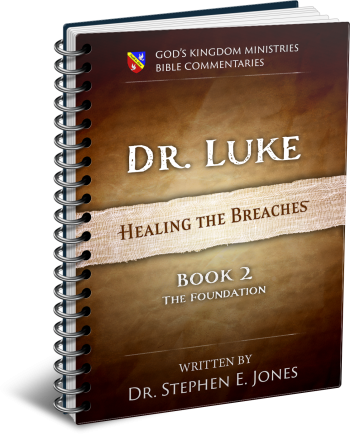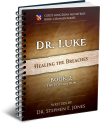Latest Posts
View the latest posts in an easy-to-read list format, with filtering options.

This book covers Luke 4-6, expounding on Jesus' baptism and early ministry. Jesus called twelve disciples and set forth the basic principles in the Sermon on the Mount.
Category - Bible Commentaries

Luke’s underlying purpose in writing his gospel was to present Christ as the Son of Man and to show that the gospel was for all equally. For this reason, he presents both men and women in a positive light, Jew and non-Jew, rich and poor, reputable as well as publicans and sinners.
The story in Luke 5:17-26 (about the man who was let down through the roof in order to obtain healing from Jesus) was a good example of the difficulty that some had in coming to Jesus. The crowd of people blocked his access to Christ, and so they came literally through the roof, as if men’s obstacles were being overruled by heaven itself. The symbolism here pictures the difficulty that women, non-Jews, and publicans often experienced in coming to God, because of the cultural attitude of the people themselves.
But this story, situated near the start of Luke’s account of Jesus’ early ministry, shows the willingness of Christ to heal the man, if he could but find a way past the crowd that stood in his way.
Why did Jesus tell him, “Friend, your sins are forgiven you”? Luke gives no indication that the man was a special sinner in need of forgiveness. He had come for healing. But Jesus took this occasion to show the authority (exousia) of the Son of Man. He showed that the authority to forgive sin was derived from the same source as the authority to heal.
In telling the man to “rise,” Jesus also drew upon terminology of resurrection, or of rising to a new way of life. In the end, raising the dead is linked to forgiveness of sin. At the Great White Throne, where the Son of Man is given authority to judge the world, He raises the dead and forgives their sin. There is, of course, a measure of judgment meted out at the same time, pictured in Daniel 7 as the river of God’s fiery law, but such judgment was designed to be corrective, destroying sin and the old way of life in order to forgive and restore the sinner.
See my book, The Judgments of the Divine Law.
The foundational law by which this forgiveness is made possible is the Law of Victims Rights. Jesus came as the Son of Man to die on the cross, taking upon Himself the responsibility for the sin of the world. In doing so, He became the victim of every sin ever committed since the dawn of time. As the Victim, He was given the right to forgive every sin and to extend that forgiveness equally and impartially to all men.
We should also keep in mind the fact that all men were victims of Adam’s sin. Romans 5:12 tells us that Adam’s sin was imputed to all men, with the result that all men were required to pay the death penalty for Adam’s sin. Not only were all men made mortal by Adam’s sin, but mortality created disease which further shortened their lives. Likewise, as Matt. 18:25 tells us, Adam’s entire estate was “sold” in order for payment to be made on his sin-debt. The estate was creation itself, and for this reason, “the whole creation groans and suffers” as it awaits its redemption (Rom. 8:22).
In other words, all men and even all of creation are victims of Adam’s sin. One man caused the problem, and one Man has resolved the problem (Rom. 5:15). Because all of creation was affected, Christ came to set all of creation free in order to reverse the effects of Adam’s sin. We are all being victimized by mortality (death), disease, and paralysis, but Jesus came to reverse this and to restore the rights of all victims.
This is the underlying purpose of Jesus’ healing ministry, as He heals the victims of Adam’s sin and forgives their sin as well. The result is seen in Luke 5:25, 26,
25 And at once he rose up before them, and took up what he had been lying on, and went home, glorifying God. 26 And they were all seized with astonishment and began glorifying God; and they were filled with fear [awe], saying, “We have seen remarkable things today.”
This story is a parable of a greater fulfillment at the Great White Throne, where His authority to forgive and heal will result in every knee bowing to Him and every tongue confessing that “Jesus Christ is Lord” (Phil. 2:10). This is a loose quotation of Isaiah 45:23, where the prophet tells us that they will “swear allegiance” to Christ. In other words, they will become true believers, rather than being locked in a never-ending cycle of disobedience, blasphemy, and hardness of heart in hell—as is so often taught in Christian circles.
Luke’s gospel, then, recognizes the Law of Victims Rights, for Christ came to reverse their victimization that was imposed upon creation through Adam’s sin. Creation’s death spiral made all men weak with the disease of mortality, thereby causing all men to sin. A literal rendering of Rom. 5:12 (Concordant Version) says,
12 Therefore, even as through one man sin entered into the world, and through sin death, and thus death passed through into all mankind, on which [eph ho] all sinned.
“Death,” or mortality, “passed through into all mankind, on which all sinned.” They did not become mortal because they sinned, but rather they sinned because they were mortal. Jesus is restoring justice to all the victims of injustice. I explained this further in chapter 13 of Creation’s Jubilee.
Luke’s account of the paralytic man being lowered through the roof is sandwiched between the leper (Luke 5:12-15) and the publican (tax collector) in Luke 5:27-32. The leper represents all who are victims of mortality, while the publican is an example of those who sin as a result of being mortal. In each case Jesus offers both healing and forgiveness, the leper being healed physically, and the publican spiritually.
Healing is a victim’s right. Restoration to Life in Christ is another victim’s right.
Intertwined with this is the fact that both lepers and publicans were outcasts in Judean society and banned from the temple and synagogue. They were denied access to God, but they found access to Jesus, who restored them through healing and forgiveness.
Luke 5:27, 28 says,
27 And after that He went out, and noticed a tax-gatherer named Levi, sitting in the tax office, and He said to him, “Follow Me.” 28 And he left everything behind, and rose and began to follow Him.
Levi is also known to us as Matthew. We read this in Matt. 9:9,
9 But as Jesus passed on from there, He saw a man, called Matthew, sitting in the tax office; and He said to him, “Follow Me!” And he rose and followed Him.
Hence, Levi the publican is Matthew the disciple and later apostle. Levi was his Hebrew name, but Dr. Bullinger says that Matthew was his Aramaic name. He also says that Matthew is an abbreviation of Matthias (which appears to be the Greek form). Many had more than one name, and often these reflected different languages.
In the flow of Luke’s narrative, this again illustrates the authority of the Son of Man to forgive sin. Jesus issued a simple call to discipleship, “Follow Me.” To follow Him meant changing his career and starting a whole new way of life. Such a change is the outworking of repentance. Jesus did not have to tell him to repent or to lead the man in a verbal confession of faith using the four spiritual laws. All of that was inherent in Levi’s action. Words are good, but God is more interested in action. In fact, if words are not followed up by action, they are worthless. But if non-verbal action is the expression of a change of heart and mind, it is acceptable to God.
I believe Jesus recognized Levi’s desire to meet and to follow Him, even though he did not presume to approach Jesus directly. He did not want to bring criticism upon Jesus by coming to Him, so Jesus went to Levi.
I have often seen people’s hearts changed simply by learning the true nature of Christ. Their prior unbelief was based upon their disbelief in the Jesus which had been presented to them by those professing to be Christians. But when they were informed of the true character of Christ, they began to follow Him without being led through the standard four spiritual laws. The change in their lives manifested the faith in their hearts.
Luke 5:29, 30 continues,
29 And Levi gave a big reception for Him in his house; and there was a great crowd of tax-gatherers and other people who were reclining at the table with them. 30 And the Pharisees and their scribes began grumbling at His disciples, saying, “Why do you eat and drink with the tax-gatherers and sinners?”
Levi brought all of his fellow outcasts to meet Jesus. He apparently understood that Jesus would not condemn them—much to the disappointment of “the Pharisees and their scribes.” Jesus view of the divine law was different. He did not come to form a club of saints but to minister to sinners.
I too understand this, for I have been criticized at times for fellowshipping with sinners and heretics. Likewise, others have been criticized for fellowshipping with me on those same grounds. The Pharisee’s attitude sprang from the carnal mind, which is more concerned about condemning others than in helping them see the truth. I have had many critics tell me my faults or tell me that I am wrong in my viewpoint, without sitting down and offering constructive help.
When Jesus ate with the crowd of publicans, He changed their lives. The Pharisees were concerned that fellowship with sinners would taint the righteous, but Jesus showed that the reverse was true.
Having come from a missionary family, I learned very early in life that my calling was not to lock myself away in a church club full of saints, but rather to go out among sinners and help them see Christ in me. I suspect that the FBI has a thick file on me as a result of being “linked” to such sinners. When people questioned me on this policy, I reminded them that my parents were missionaries to former headhunters in the Philippines. (I can see the headline now: “Missionaries linked to headhunters.”)
We need to get out of the club and find links to sinners. But don’t expect the Pharisees among us to appreciate it.
Luke 5:31, 32 says,
31 And Jesus answered and said to them, “It is not those who are well who need a physician, but those who are sick. 32 I have not come to call the righteous but sinners to repentance.”
Luke, the physician, understood this saying. We can only wonder how many house calls he had made as a physician when called upon to minister to the sick. Jesus took it a step further, showing that He was the Great Physician who could heal not only sickness, but also their very way of life. Being cured or healed of disease was likened to repentance, which heals the inner disease of the heart.